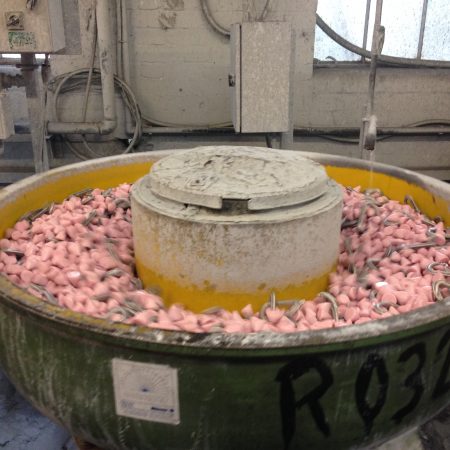A few weeks ago Facewest’s Graham and I were fortunate enough to go on a 2 day training course in North Wales courtesy of Mountain Equipment. We spent the first day of the course trying out some of the Mountain Equipment clothing in the mountains of Snowdonia – blog on this coming soon. The second day consisted of a tour around DMM’s factory in Llanberis followed by the chance to test some carabiners to their breaking strain and beyond. We also got the chance to do some climbing with some shiny DMM gear.

DMM climbing carabiners start life as a roll of aluminium which is then bent into shape.
They are then hot forged. This is essentially a giant press which stamps the hot aluminium into the design of the carabiner.

This process creates a fair amount of wasted metal around the shape of the carabiner, this is removed and recycled. The amount of waste from each product is one of the areas which DMM are always trying to improve, for obvious reasons.

Once the majority of the wasted aluminium has been removed there are a lot of sharp edges and burrs left on the carabiner. These are removed by a very strange process. The pink things in the photo are smooth ceramic cones which are put into the big vibrating tub with the carabiners. By vibrating I mean as in driving down a cobbled road at 50mph. This is done for 8-10 hours and when it’s finished the carabiners are completely smooth. There are a variety of sizes of ceramic, cones the ones in the photo are quite large, as they have to be able to get to every surface of the product, so for more detailed products with small holes in them smaller ceramics are required. Unfortunately the only way to separate the ceramic from the product is by hand, which I can imagine is a bit of a pain when you’re looking for the last 1 or 2!

Another step in the production line which is sometimes done before the ‘vibrating tubs’ bit is the heat treatment which is where the not yet carabiners are heated up on racks in a large oven enough to make them almost liquid. They are then cooled quickly by putting them in cold water. This process is what gives the aluminium its strength as the heat makes the molecules which make up the aluminium spread evenly throughout the metal, the cold then causes them to set very quickly in that position. Sadly, we didn’t get to see this in action, but I imagine the ‘tsssss’ of the hot carabiners going into the cold water would have been somewhat bigger than putting a hot frying pan under a cold tap.
The carabiners then have any shapes and finer design points cut into them by a CNC machine – some products are also so similar that until this point they use the same hot forging press and are only differed when it comes to the CNC part of the process. They are also sent off site for anodising which DMM don’t do themselves for a number of reasons. Anodising is where they get their chosen colour, it also makes the outer of the metal a lot more resistant to corrosion – your gear will get wet at some point if you climb in the UK!
All the assembly is done at DMM, we saw some gates being attached to some carabiners – a fiddly job involving putting the spring and a small plastic part between the gate and the carabiner so the spring mechanism always keeps the gate closed. One of our group had a go at doing this and didn’t manage to do it with several attempts, making the speed at which the DMM assemblers completed each carabiner even more impressive.
The final stage is quality control, in which each individual product is checked manually that the product functions properly and there aren’t any small defects on the surface. They are then laser etched, by a machine not dissimilar to our own laser engraving machine which we use to engrave Leatherman Tools, with their individual batch, product number and date so they can be traced back to exactly where, when and what was part of the manufacturing process.

It’s fair to say I was already a DMM fan, the majority of my rack is DMM gear, so there was no winning over required on the part of DMM for me. It was great to see how the climbing gear I use is created and the attention to detail which goes into every part of the process, both in terms of the creation and design of the individual products as well as how DMM organise and manage their resources to achieve maximum output without compromising the quality.
Thoughts from the Mountain Equipment testing day coming soon.


